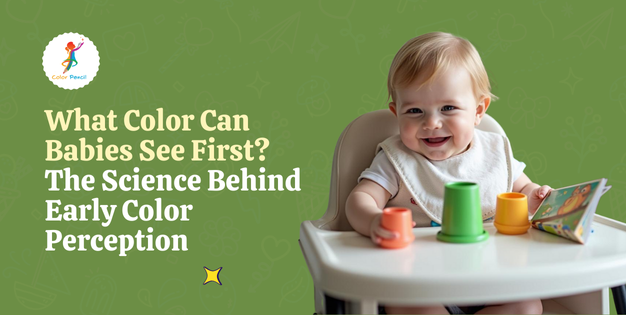
Top 10 Flashcard Combos for Holistic Toddler Learning
Did you know that up to 80% of a toddler’s brain develops in the first five years? As a parent, you’re likely eager to give

As a new parent, you might find yourself wondering: when can babies see color, and can newborns see color at all? The truth is, babies don’t start out seeing the world the way adults do. In fact, when do infants start seeing color is a fascinating question tied to infant brain and eye development. In the early weeks, their vision is limited mostly to black, white, and shades of gray. But by around 8 weeks, color perception begins—starting with red, the first color babies can typically recognize.

Newborns are born with limited visual clarity and infant color perception. Their eyes can detect light and motion, but color vision takes time to develop. During the first month, babies primarily see black, white, and high-contrast patterns.
By 8 weeks, they begin to see shades of red because red has the longest wavelength and stands out to their immature photoreceptors. Soon after, they can distinguish between red and green, followed by blue and yellow. Most babies develop full color vision by 4 to 5 months of age.
🍼 Did You Know? Red is the first color babies see due to its longer wavelength, making it more visible to the developing retina.
Colors stimulate your baby’s visual development, but interactive learning activities can help foster cognitive skills. Discover more about interactive learning in early childhood.
💡 Tip: High-contrast colors, such as black and white or bold red patterns, can help stimulate a newborn’s vision and encourage focus.

When can newborns see color? No, newborns cannot see color immediately after birth. Their vision is blurry and limited to black, white, and shades of gray. This is because their retinas and optic nerves are still maturing.
By the end of the first month, infants can detect some light hues, but it’s not until 2 to 3 months that colors—starting with red—become visible. This gradual process is a crucial milestone in visual development. According to the American Optometric Association, infants begin developing their focus and ability to see color over the first few months.
Babies start to see color around 8 weeks of age. What color do babies see first? Red usually appears first, followed by green, blue, and yellow. Around 4 to 5 months, infants develop the ability to see the full spectrum of colors.
This timeline may vary slightly for each child, but it marks a key phase in sensory and cognitive growth. During this time, visual stimulation from colorful surroundings can support learning and brain development.
Colors influence not only vision but also emotional and cognitive responses in babies. Here’s a quick guide to how different colors impact infants:
💡 Tip: Use red and yellow for play areas to encourage engagement, while blue and green work well for relaxation zones like nurseries.

Since colors affect mood and brain function, parents can incorporate the best colors for child development into their baby’s environment to aid learning and emotional well-being.
Choosing the right colors for your baby’s room can make a difference.
Babies respond best to bold, high-contrast colors in their early months.
Looking for a gentle, sensory-rich way to reinforce your baby’s growing color awareness?
Our latest video from Color Pencil TV is the perfect visual companion to this stage of development.
🎥 Title: Learn Colours in Nature | Fun Educational Song for Toddlers | Color Pencil TV
Set to a soft, engaging melody and filled with nature-based visuals, this video helps babies and toddlers begin to associate real-world colors with the objects around them—think green leaves, yellow sunshine, and red flowers.
It’s a beautiful way to complement what your child is starting to see and understand.
Feeling Overwhelmed? Let’s Talk! Join Our Parent Forum and Get Expert Advice & Support!
Red is the first color babies typically recognize, followed by green and blue.
A: Most babies begin seeing color around 8 weeks old.
No, they initially see only black and white, gaining color vision after the first month.
Bright colors like red and yellow stimulate excitement, while blue and green promote relaxation and calmness.
Soft blues and greens are ideal for sleep, while vibrant colors like red and yellow work well in play areas.
Yes! High-contrast patterns and bold colors help develop visual tracking, focus, and early cognitive skills.
Use colorful toys, books, and clothing, and create visually engaging spaces to encourage their visual and brain development.
Understanding when babies start to see color helps parents create engaging, supportive environments that boost both visual and brain development. From recognizing red as the first color to exploring the entire rainbow by 5 months, color perception is a beautiful part of your baby’s growth journey.
Add bold colors to their world—one hue at a time—and watch them light up with discovery.